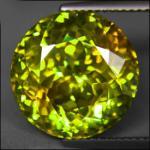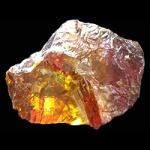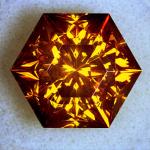
Classes- Alabama
- Alaska
- Arizona
- Arkansas
- California
- Colorado
- Connecticut
- Delaware
- Florida
- Georgia
- Hawaii
- Idaho
- Illinois
- Indiana
- Iowa
- Kansas
- Kentucky
- Louisiana
- Maine
- Maryland
- Massachusetts
- Michigan
- Minnesota
- Mississippi
- Missouri
- Montana
- Nebraska
- Nevada
- New Hampshire
- New Jersey
- New Mexico
- New York
- North Carolina
- North Dakota
- Ohio
- Oklahoma
- Oregon
- Pennsylvania
- Rhode Island
- Tennessee
- Texas
- Utah
- Vermont
- Virginia
- Washington
- West Virginia
- Wisconsin
- Wyoming
| Structure : Cubic Hardness : 3.5 Specific Gravity : 4.09 Refractive index : 2.36 - 2.3 Doubly Refracting (bi-refraction) : none Common as an important ore of zinc, gem quality sphalerite is a rare collector stone. The mineral is usually nearly black in color but is occaisionally found in transparent pieces of an orange or yellowish brown hue. Clean pieces are extremely rare. With a dispersion three times higher than diamond, gem sphalerite is one of the brightest and most dispersive of all minerals. It has a hardness of 3.5 - 4 as well as 6 directions of perfect cleavage. Spahlerite is very difficult to polish and is too soft to be used in jewelry. Sphalerite (ZnS) is a mineral that is the chief ore of zinc. It consists largely of zinc sulfide in crystalline form but almost always contains variable iron. When iron content is high it is an opaque black variety, marmatite ((Zn,Fe)S). It is usually found in association with galena, pyrite, and other sulfides along with calcite, dolomite, and fluorite. Miners have also been known to refer to sphalerite as zinc blende, mock lead, false galena and black-jack. The mineral crystallizes in the cubic crystal system. In the crystal structure, zinc and sulfur atoms are tetrahedrally coordinated. The structure is closely related to the structure of diamond. The hexagonal analog is known as the wurtzite structure. The lattice constant for zinc sulfide in the zincblende crystal structure is 0.542 nm. Its color is usually yellow, brown, or gray to gray-black, and it may be shiny or dull. Its luster is resinous. It has a yellow or light brown streak, a hardness of 3.5 - 4, and a specific gravity of 3.9-4.1. Some specimens have a red iridescence within the gray-black crystals; these are called (ruby sphalerite.) The pale yellow and red varieties have very little iron and are translucent. The darker more opaque varieties contain more iron. Some specimens are also fluorescent in ultraviolet light. The refractive index of sphalerite (as measured via sodium light, 589.3 nm) is 2.37. Sphalerite crystallizes in the isometric crystal system and possesses perfect dodecahedral cleavage. Gemmy, pale specimens from Franklin, New Jersey (see Franklin Furnace) are highly fluorescent orange and/or blue under longwave ultraviolet light and are known as cleiophane, an almost pure ZnS variety. Crystals of suitable size and transparency have been fashioned into gemstones, usually featuring the brilliant cut to best display sphalerite's high dispersion of 0.156 (B-G interval)—over three times that of diamond. Freshly cut gems are lively with an adamantine luster and could conceivably be mistaken for a fancy-colored diamond in passing, but due to sphalerite's softness and fragility the gems are best left unset as collector's or museum pieces (although some have been set into pendants). Collectors may pay a premium for stones over one carat (200 mg), as clean crystals are usually quite small. Gem-quality material is usually a yellowish to honey brown, red to orange, or green; the two most important sources are the Chivera mine, Cananea, Sonora, Mexico; and the Picos de Europa, Cordillera Cantabrica, near Santander on Spain's northern coast. |
- Birth Stone Gems
- Wedding & Anniversary Gems
- How To Guides
- Fireable Gems
- Nonprofits and Guilds
- Gem Show
- Gem Stone Information
- ·Abalone
- ·Achroite (Tourmaline)
- ·Agate ( Chalcedony)
- ·Alexandrite
- ·Almandine ( Garnet )
- ·Amber
- ·Amethyst ( Quartz)
- ·Ammolite
- ·Andalusite
- ·Andradite Garnet
- ·Apatite
- ·Aquamarine ( Beryl )
- ·Aventurine ( Quartz )
- ·Azurite
- ·Benitoite
- ·Bloodstone ( Chalcedony )
- ·Brown Quartz ( Smokey Quartz )
- ·Calcite
- ·Carnelian ( Chalcedony )
- ·Cassiterite
- ·Celestine
- ·Cerussite
- ·Chalcedony
- ·Chatoyant Quartz
- ·Chrysoberyl
- ·Chrysocolla
- ·Chrysoprase (Chalcedony)
- ·Citrine ( Quartz )
- ·Coral
- ·Danburite
- ·Diamond
- ·Diopside
- ·Dioptase
- ·Dravite ( Tourmaline)
- ·Emerald ( Beryl )
- ·Enstatite
- ·Epidote
- ·Euclase
- ·Fire Agate (Chalcedony)
- ·Fluorite
- ·Gold
- ·Goshenite (Beryl)
- ·Grossular Garnet (Tsavorite Garnet)
- ·Gypsum
- ·Heliodor ( Beryl )
- ·Hematite
- ·Hessonite (Grossular Garnet)
- ·Imperial Topaz
- ·Indicolite ( Tourmaline)
- ·Iolite
- ·Ivory
- ·Jadeite
- ·Jasper (Chalcedony)
- ·Jet
- ·Kornerupine
- ·Kunzite
- ·Kyanite
- ·Labradorite
- ·Lapis Lazuli ( Lazurite)
- ·Lazulite
- ·Malachite
- ·Meerschaum
- ·Microcline
- ·Milky Quartz
- ·Moonstone
- ·Morganite ( Beryl)
- ·Nephrite ( Jade)
- ·Obsidian
- ·Oligoclase
- ·Onyx
- ·Opal
- ·Orthoclase
- ·Padparasha ( Corundum)
- ·Pearl
- ·Peridot
- ·Pink Topaz ( Mercury Myst Vapor )
- ·Plasma ( Chalcedony)
- ·Prase ( Chalcedony )
- ·Prehnite
- ·Pyrite
- ·Pyrope ( Garnet )
- ·Rock Crystal ( Quartz )
- ·Rubellite ( Tourmaline)
- ·Ruby ( Corundum)
- ·Sapphire ( Corundum)
- ·Sardonyx ( Chalcedony)
- ·Scapolite
- ·Schorl (Tourmaline)
- ·Shell
- ·Spessarite (Garnet)
- ·Sphalerite
- ·Spinel
- ·Spodumene (Hiddenite - Triphane)
- ·Tanzanite (Zoisite)
- ·Tektites ( Moldavite )
- ·Tiger Eye
- ·Titanite (Sphene)
- ·Topaz
- ·Turquoise
- ·YAG (Garnet)
- ·Zircon


